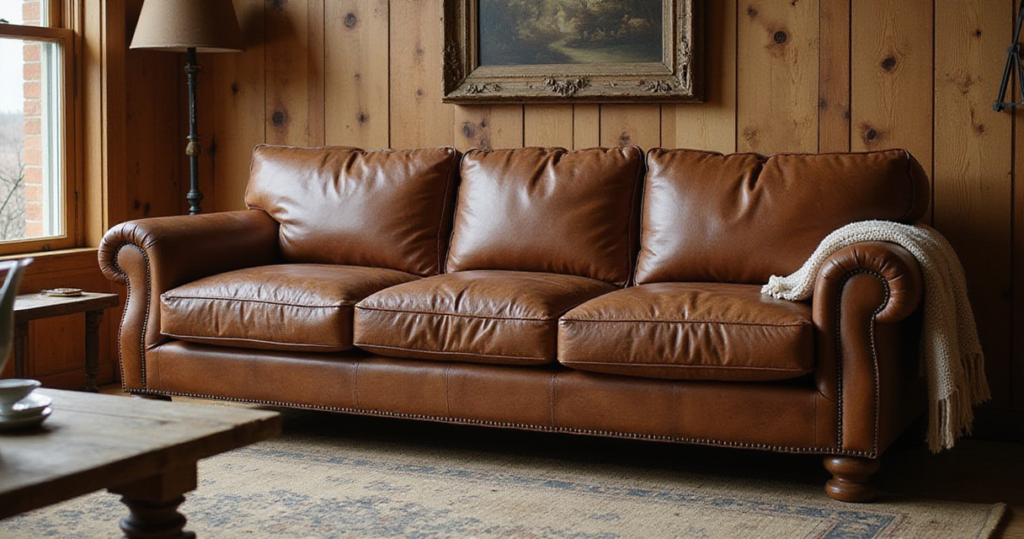There’s a certain alchemy to a British living room done right. It’s that feeling you get when you sink into a sofa that seems to sigh with you, where the scent of old leather and woodsmoke hangs faintly in the air, and every object looks as if it has a story to tell. It’s a room that hasn’t been “designed” so much as it has evolved. This isn’t about chasing the fleeting trend of “rustic,” which, I must confess, can often look a bit like a stage set for a lumberjack musical.
No, this is about authenticity. It’s about understanding that the glorious patina on a piece of furniture is earned, not applied with a paint gun in a factory. It’s the difference between a country house and a “country-themed” house. Whether you’re trying to coax some soul into a sharp-edged London flat or thoughtfully updating a proper country pile, the principles are the same. It’s a delicate dance between the rugged and the refined, comfort and character, the old and the new.
So, pour yourself something restorative and let’s talk about how to get that look—the real look. The one that feels like coming home.
1. The Indispensable Leather Sofa
Let’s begin with the absolute cornerstone of a comfortable sitting room: the leather sofa. And I’m not talking about those shiny, monolithic things that look as though they belong in a corporate waiting room. I mean a proper, well-bred sofa—perhaps a classic Chesterfield or a deep-buttoned Howard-style piece—that will outlive us all and only get better for it. Distressed leather celebrates a life well-lived. The faint ring mark from a forgotten cup of tea, the scuffs from a boisterous spaniel’s claws, the gentle sheen where countless hands have rested… these aren’t imperfections. Honestly, they’re the entire point. They are the furniture’s biography.
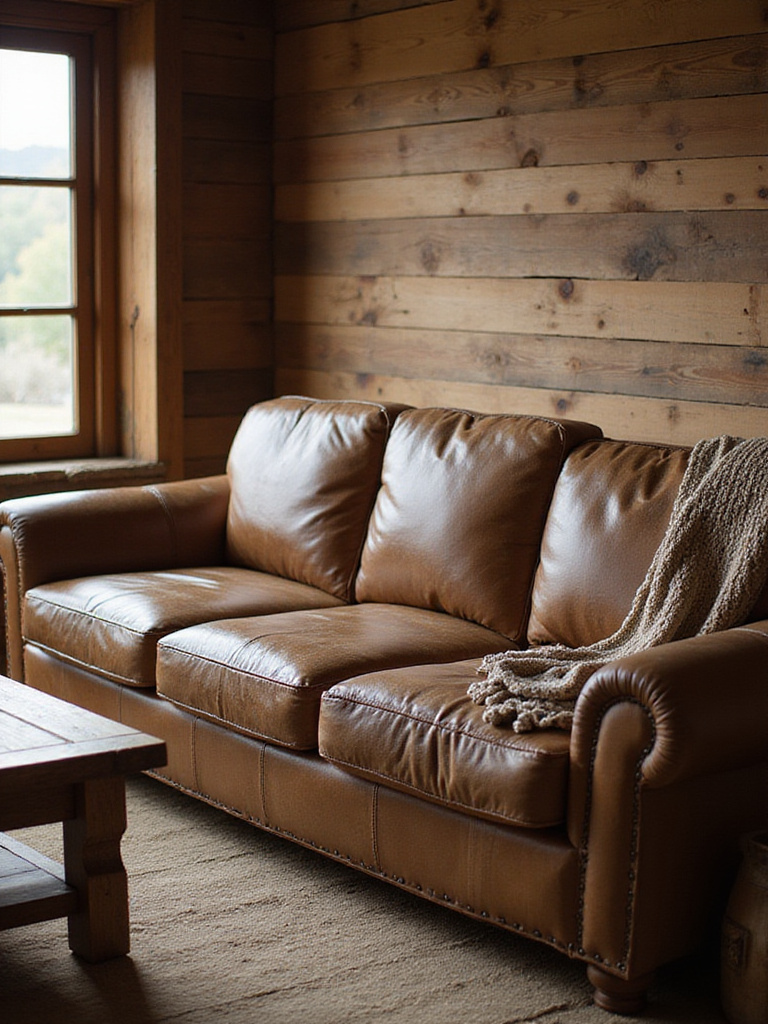
Think of it as an investment in future comfort. A truly well-made leather sofa, with a kiln-dried hardwood frame and proper eight-way hand-tied springs, will withstand decades of Sunday papers and family film nights. When you’re looking, seek out full-grain aniline leather. It’s the most natural and develops the most beautiful, complex patina. If the thought of spills from little ones (or big ones, for that matter) gives you heart palpitations, a semi-aniline top-grain leather is a perfectly respectable compromise, offering a bit more resistance without looking too plasticky. It’s the one piece that says, “Come in, sit down, nothing is too precious here.”
2. The Civilised Sectional for Grand-Scale Comfort
For those blessed with a generously proportioned room—a converted barn or a drawing-room with soaring ceilings—a sectional can seem daunting. It can so easily swallow a space whole. But choose one with a visible reclaimed wood frame, and it transforms from a bulky brute into an architectural anchor. Each knot and saw mark in the timber tells a story, lending a gravitas that a fully upholstered piece simply can’t match.
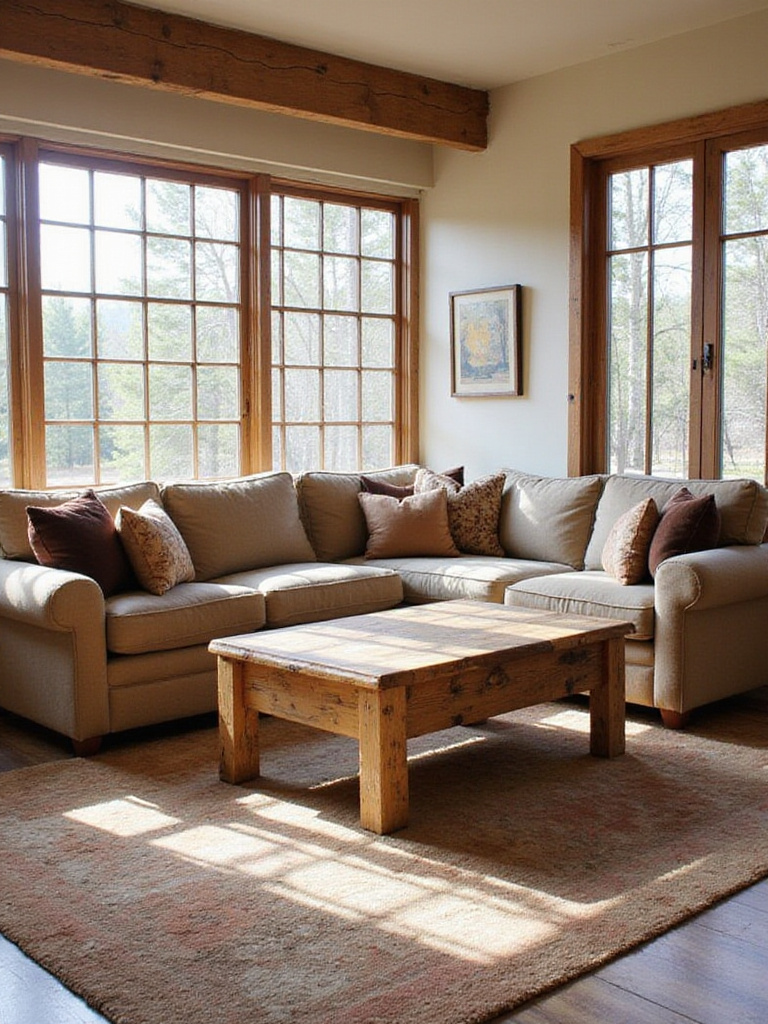
There’s a lovely, very British “make do and mend” sensibility to using reclaimed wood, isn’t there? It feels responsible, yes, but more importantly, it has character baked in. The timber, often old-growth wood salvaged from dilapidated farm buildings or factories, is dense and wonderfully stable. Paired with modern cushions (upholstered in a durable tweed or a performance linen, perhaps), it’s the perfect marriage of historical soul and contemporary comfort. The key is to break up its mass—an L-shape or U-shape creates instant zones for conversation, separating a chat by the fire from a quiet corner for reading.
And a reading corner is not a luxury; it’s a necessity. Which brings me to my next point.
3. An Upholstered Armchair for Your Reading Nook
Every civilised home needs a reading nook. A proper one. It’s a sort of domestic sanctuary, a visual cue to the rest of the household that you’ve temporarily seceded from the union. The cornerstone of this secession is, of course, the perfect armchair. This is where you can truly indulge in classic British form. Think of a tufted wingback, its “ears” designed to block drafts in chilly manor houses, creating a warm pocket of air for the sitter. Or a generous, low-slung club chair, practically begging you to curl up in it with a novel and a dog at your feet.
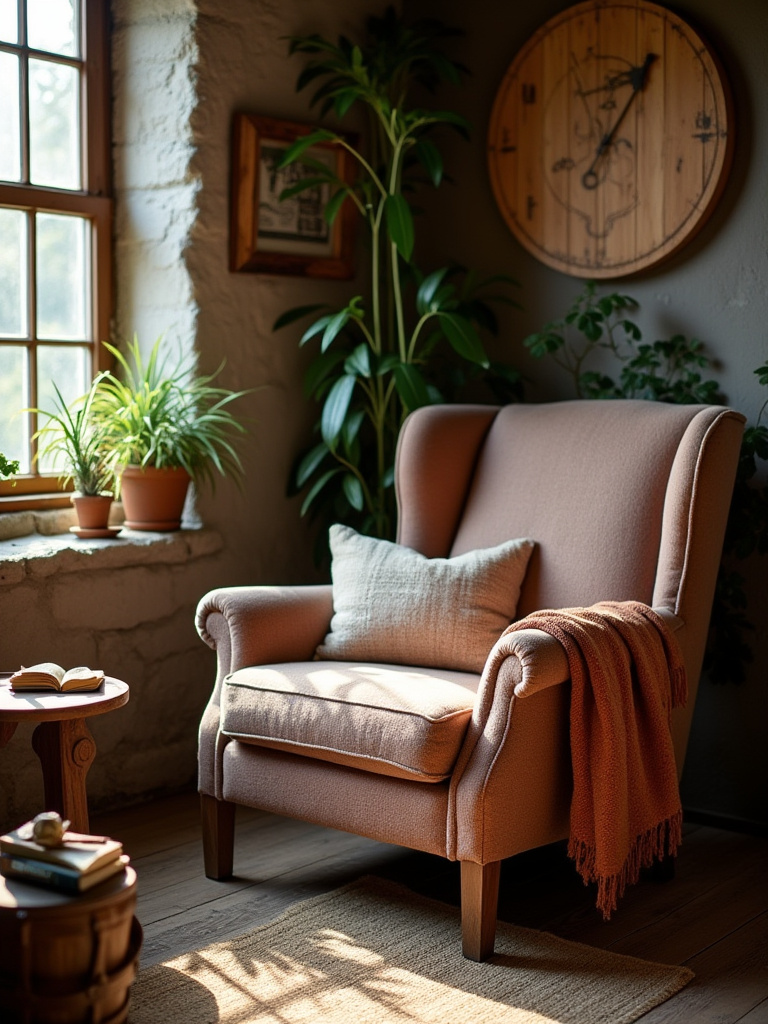
I remember specifying a pair of magnificent Howard and Sons armchairs for a client’s library in the Cotswolds. They were ruinously expensive but had the most perfect, slouchy posture. The effect was immediate. The room went from a formal space to one you desperately wanted to spend time in. The chair’s position is just as important. It must have its own light source—a window for daytime, a good, focused lamp for the evening. It should feel part of the room, yet somehow splendidly isolated.
Now, where to put your drink?
4. A Live-Edge Table as the Room’s Centrepiece
A live-edge coffee table is nature’s own sculpture. Instead of forcing wood into a perfect rectangle, you are celebrating its true, organic form. It immediately becomes the gravitational centre of the room, a conversation piece that is both ruggedly handsome and endlessly tactile. It’s an antidote to the flat-pack world, a slab of pure, unadulterated reality.
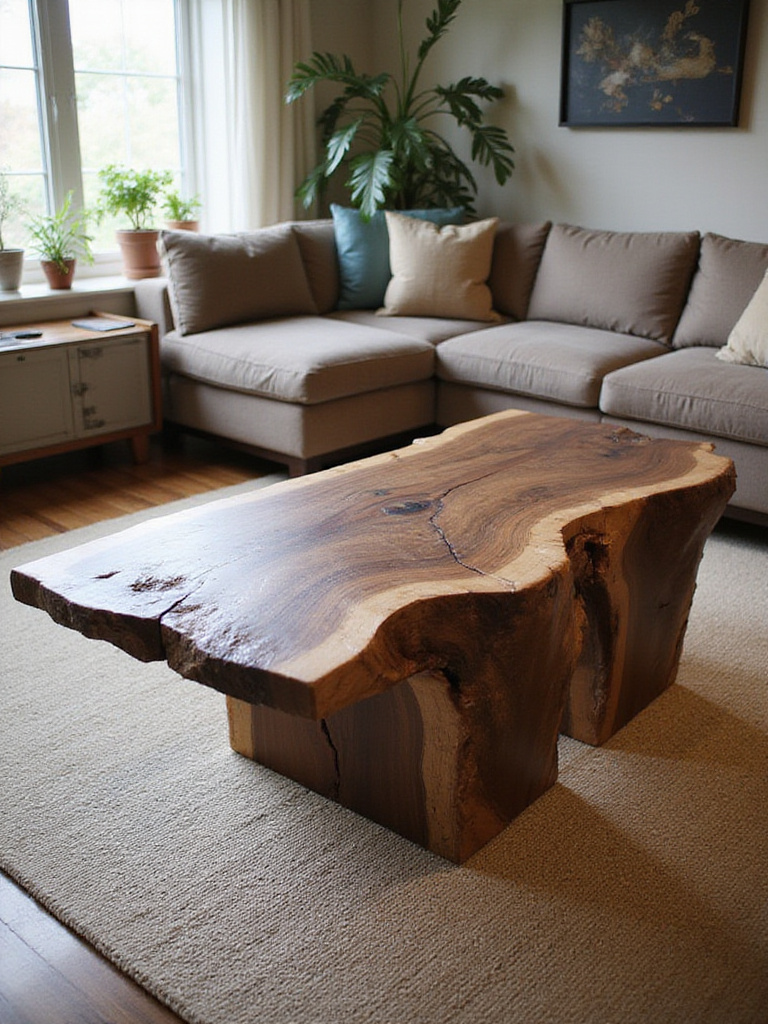
Sourcing one is a bit of a treasure hunt. Each piece of timber is unique. Walnut offers those deep, chocolatey tones, while oak feels sturdy and quintessentially English, and something like a slice of yew can have the most breathtaking grain. What really modernises it is the base. Placing a raw, rustic slab of wood on slender, dark steel legs creates a fantastic tension between the industrial and the organic. It’s this contrast that keeps the look fresh and not like something out of a provincial pub. Just be mindful of scale. A general rule I follow is to have the coffee table be about two-thirds the length of your main sofa. It ensures the relationship between the pieces feels harmonious, not accidental.
This central statement piece needs its supporting cast, of course.
5. Sturdy End Tables: The Unsung Heroes
End tables are the hard-working butlers of the living room. They are utterly essential but often overlooked. They must be practical—holding a lamp, a stack of books, a half-finished crossword, a glass of wine—but they must also quietly reinforce the room’s character. This is where you can have a bit of fun with smaller, sturdier pieces.
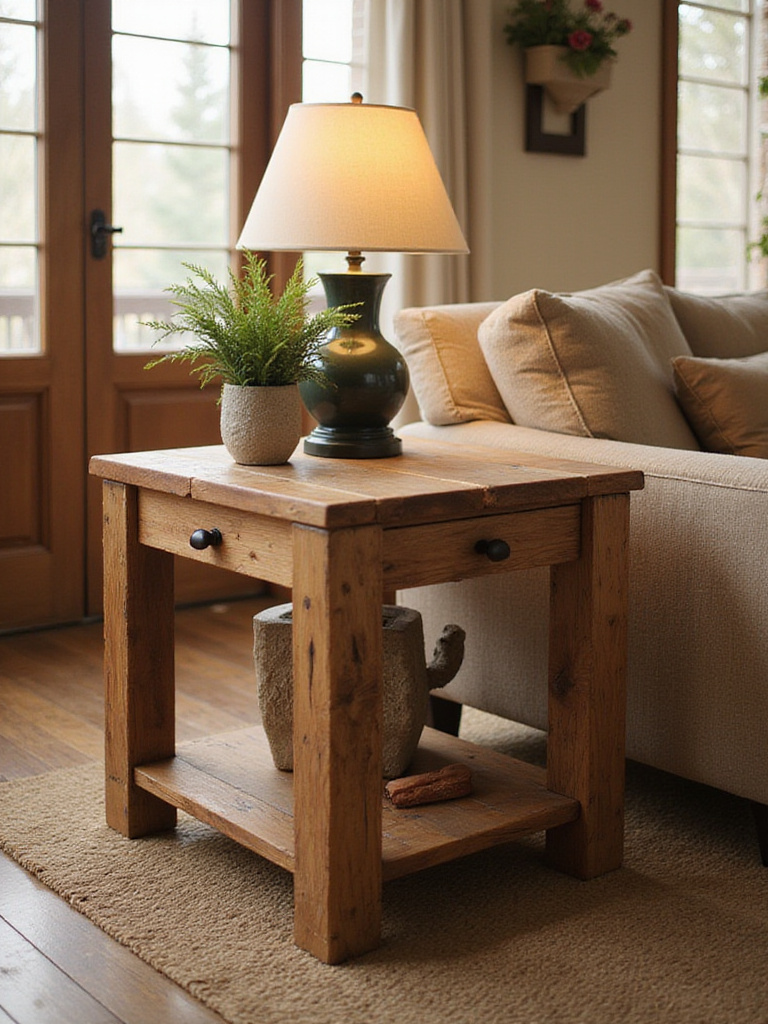
I look for tables made of solid wood with traditional joinery, like mortise-and-tenon or dovetail joints. These are signs of quality that tell you a piece was made to last, not just to sell. Think about their purpose. A small drawer is a godsend for hiding away clutter like reading glasses and remote controls. The height is also terribly important. For ease of use, an end table should sit within an inch or two, higher or lower, of the sofa’s arm. Any more of a difference and reaching for your G&T becomes a rather undignified lunge.
6. The Versatile Console Table for a Proper Welcome
The console table in your entryway is your home’s opening paragraph. It sets the tone for everything that is to follow. It’s a workhorse, a spot to drop keys and sort the post, but it also makes the first aesthetic statement. A long, narrow table made of reclaimed elm or distressed painted pine can bring rustic charm to even the most formal hallway.
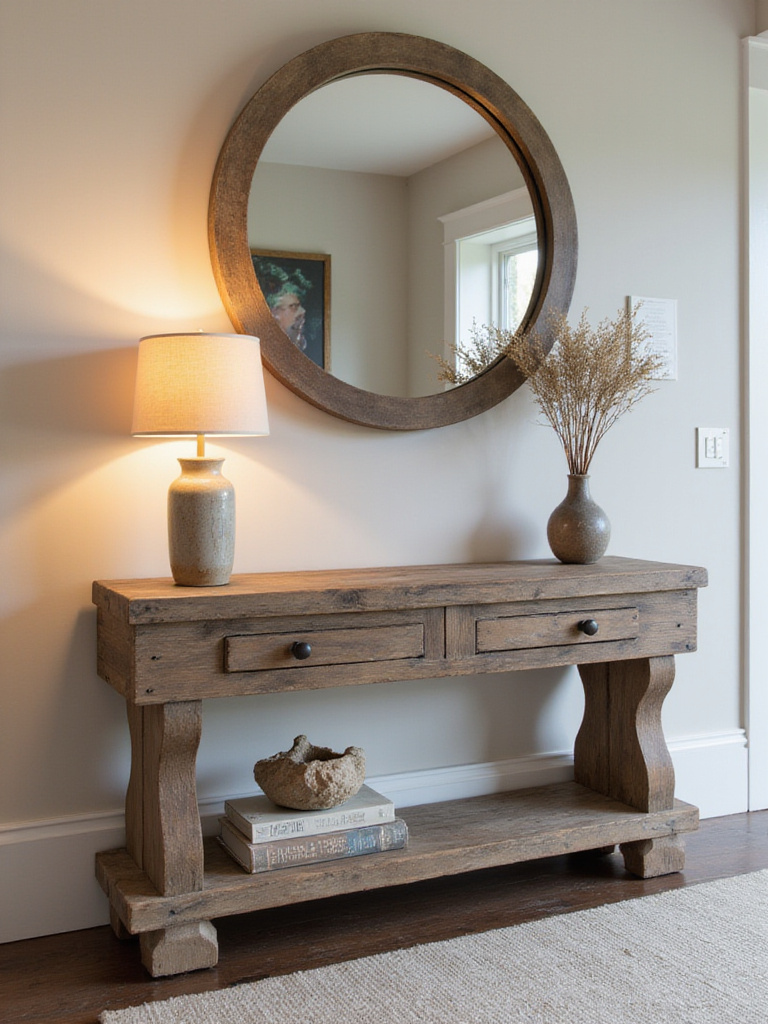
I find that the best ones blend utility with display. A beautiful ceramic bowl becomes the designated key-drop. A pair of lamps adds a warm, welcoming glow in the evening. Below, a large wicker basket can wrangle shoes or umbrellas. It brings order to the daily chaos of coming and going, all while telegraphing your home’s story. It’s the first hint of the comfortable, characterful rooms that lie beyond.
7. Open Shelving: Curating Your Life
Open shelving is for the brave. It’s an honest, exposed way to store and display your treasures, turning them into a key part of your décor. Unlike a cabinet that hides everything away, shelves demand you become a curator of your own life. It’s a wonderful way to add vertical interest and personality to a room.
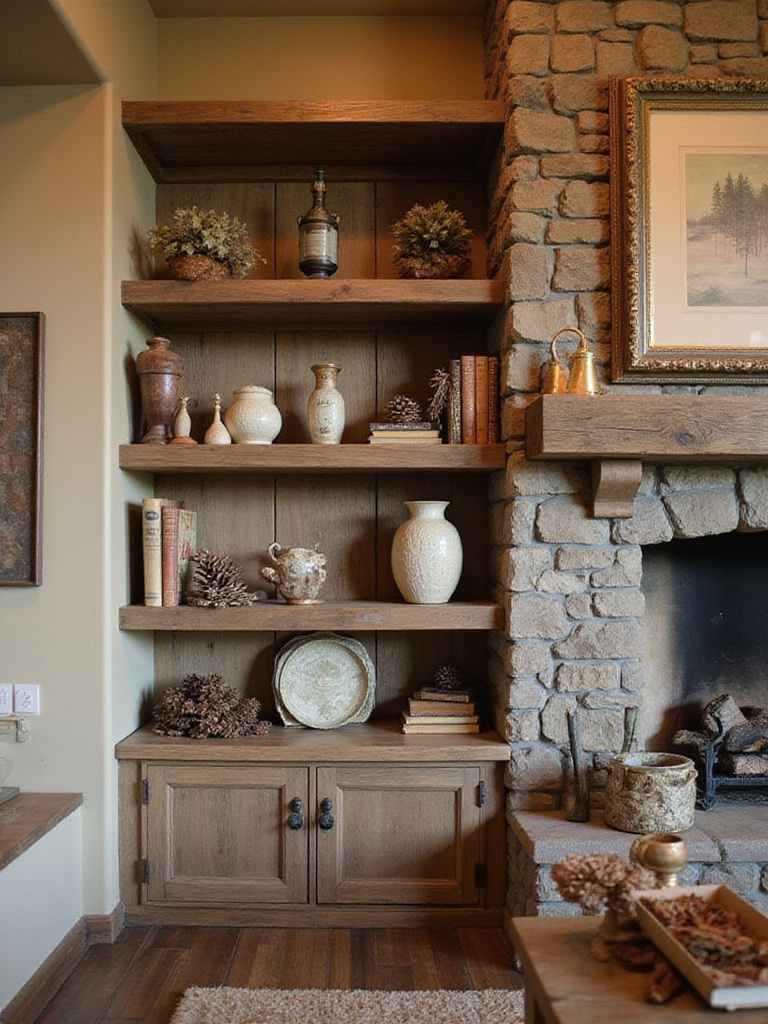
The secret to styling them isn’t about perfection; it’s about rhythm. It’s much like arranging flowers. Group items in odd numbers, vary their height and texture, and—this is critical—don’t be afraid of empty space. Breathing room is what separates a curated collection from simple clutter. I like to mix leather-bound books with a few pieces of studio pottery, perhaps a framed photograph, and something living, like a small potted fern. The shelves themselves, whether simple planks of reclaimed wood on iron brackets or more integrated joinery, add their own layer of texture.
Of course, some things simply must be hidden from view.
8. The Barnwood Media Console: A Modern Compromise
Let’s be honest, the enormous black rectangle of a television is the sworn enemy of almost any thoughtfully designed interior, especially a rustic one. A media console made from authentic barnwood is the perfect Trojan horse. It allows you to smuggle modern technology into a traditional room without shattering the illusion.
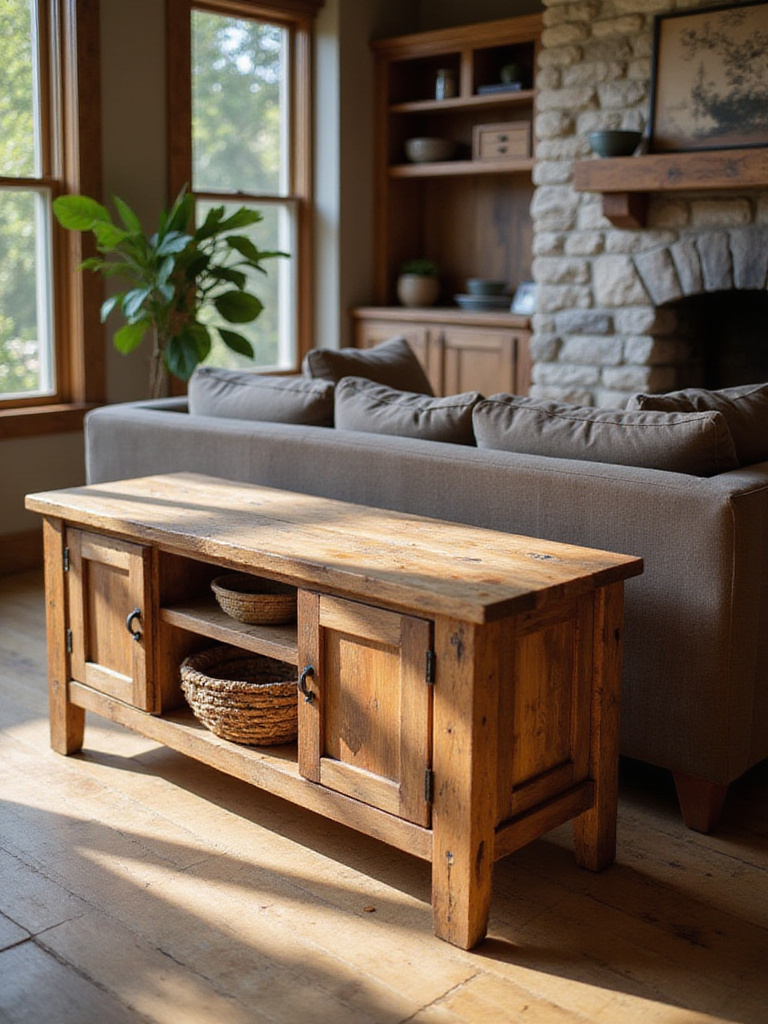
A good one is designed with function in mind first. It needs proper ventilation to stop your electronics from cooking themselves, and clever cable management to hide that ghastly nest of wires. The best have slatted or cloth-covered doors that allow remote signals to pass through. From the outside, all you see is the warm, weathered texture of reclaimed timber, with its nail holes and saw marks speaking of a past life on a farm. The television recedes, and the piece of furniture comes forward.
9. The Hard-Working Leather Ottoman
In the grand tradition of British practicality, the leather ottoman is a master of multitasking. It’s a footrest. It’s an extra seat for a party. Or a coffee table (with a tray on top). And if you choose a storage version, it’s a secret weapon against clutter—the perfect place to stash extra throws, board games, or children’s toys.
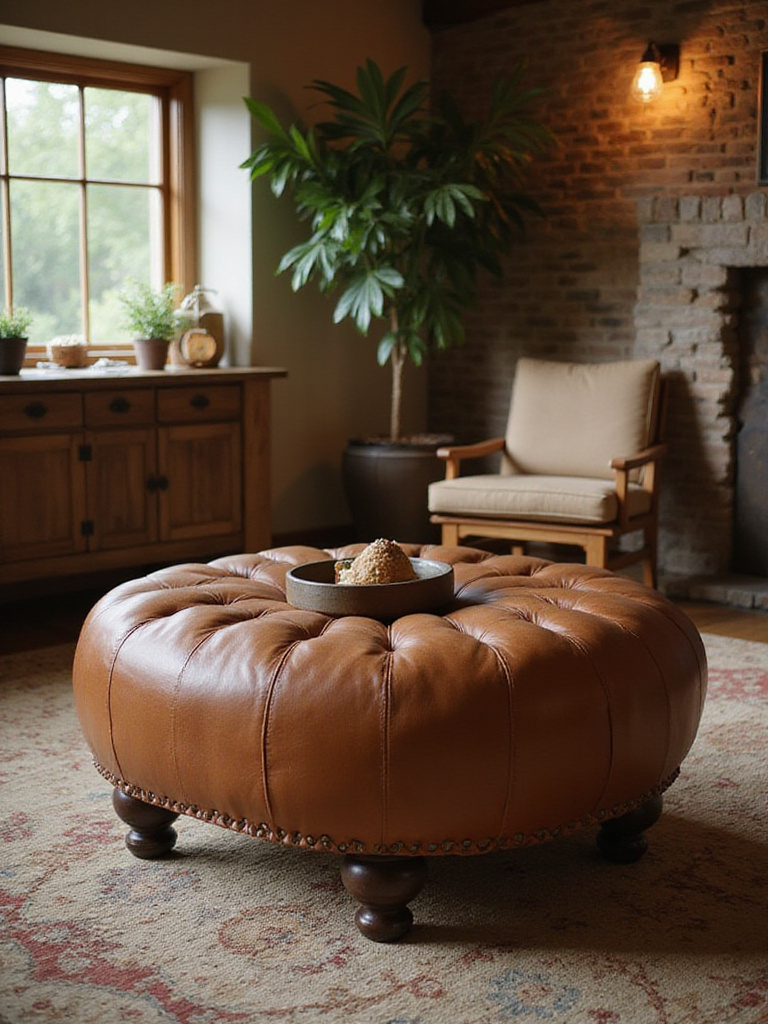
Especially in smaller homes, like a London flat where every square inch is precious, a piece that can perform three or four duties is invaluable. The soft, padded surface is also a rather brilliant, child-friendly alternative to a hard-edged coffee table. Again, a distressed leather is your friend here. It’s forgiving, handsome, and develops a rich character that simply gets better with a bit of rough and tumble.
10. The Reclaimed Wood Bench in an Awkward Corner
We all have them: those odd, transitional spaces. Under a window, along a stretch of empty wall in a hallway, at the foot of a bed. They feel too small for a chair but too empty to ignore. Enter the simple, humble, reclaimed wood bench. It’s the perfect solution.
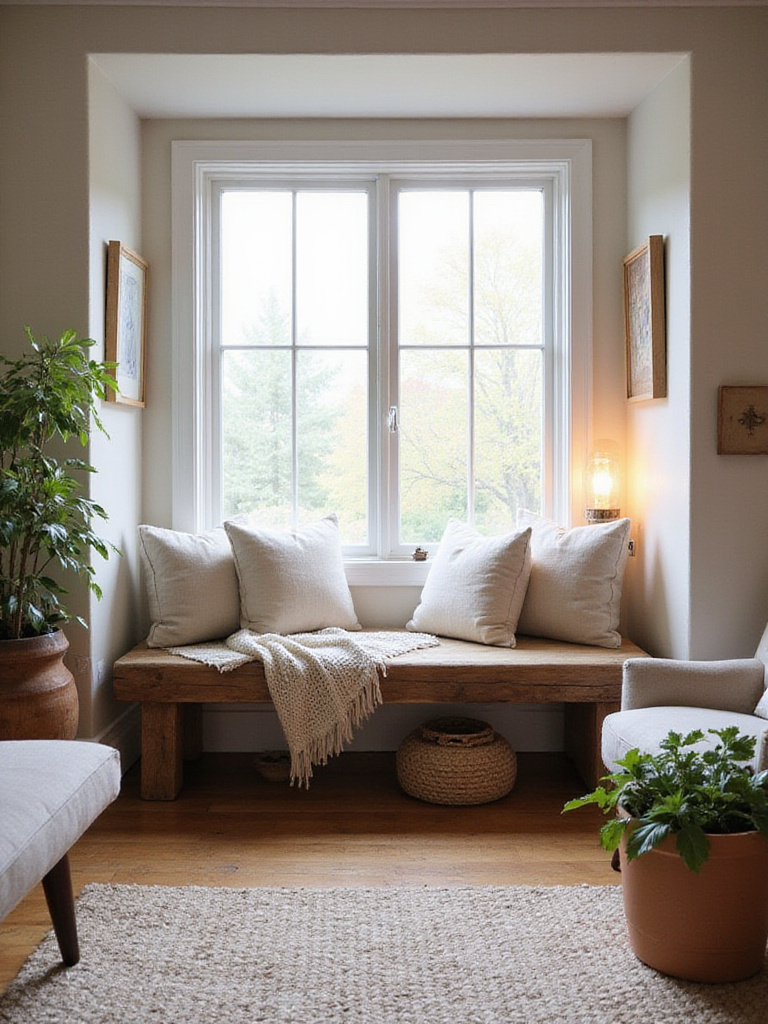
A bench is inherently more sociable than a chair. It can host one person seeking a moment of solitude or three friends deep in conversation. It has a democratic, unpretentious quality. I love placing one beneath a window, perhaps softened with a long cushion in a ticking stripe or a few linen pillows. It turns a forgotten bit of architecture into a destination, a perfect spot to perch and look out at the garden.
11. Celebrating the Story of Upcycled Timber
There’s a world of difference between “reclaimed” and “upcycled,” though the terms are often used interchangeably. Upcycling is about creative reincarnation. It’s taking something like an old factory pallet, a slice of a bowling alley lane, or structural timbers from a dismantled pier and giving them a completely new and unexpected life as furniture.
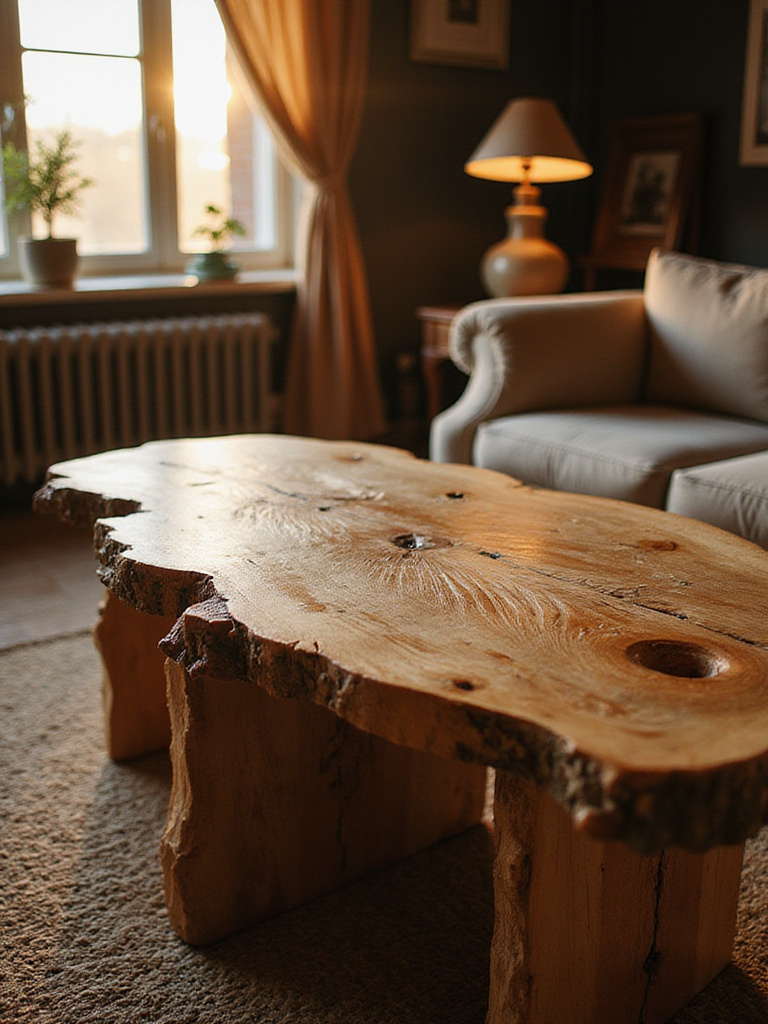
This is where true originality lies. The appeal is in the backstory. I once saw a coffee table made from the hatch cover of an old cargo ship; you could still see the faded stencilling and the dents from its years at sea. You can’t buy that kind of history. It requires vision and skill to transform these materials into something both beautiful and functional, but when done well, the result is a piece that is utterly unique and a brilliant testament to sustainable design.
12. Distressed Leather Upholstery: Perfectly Imperfect
We’ve touched on leather, but let’s dive into the philosophy of “distressed.” It’s an art form, really. Proper distressing isn’t about faking age; it’s about accelerating the character-building process that high-quality leather would naturally undergo over decades. It’s done through tumbling, waxing, and hand-finishing to create subtle variations in colour and a lived-in texture from day one.
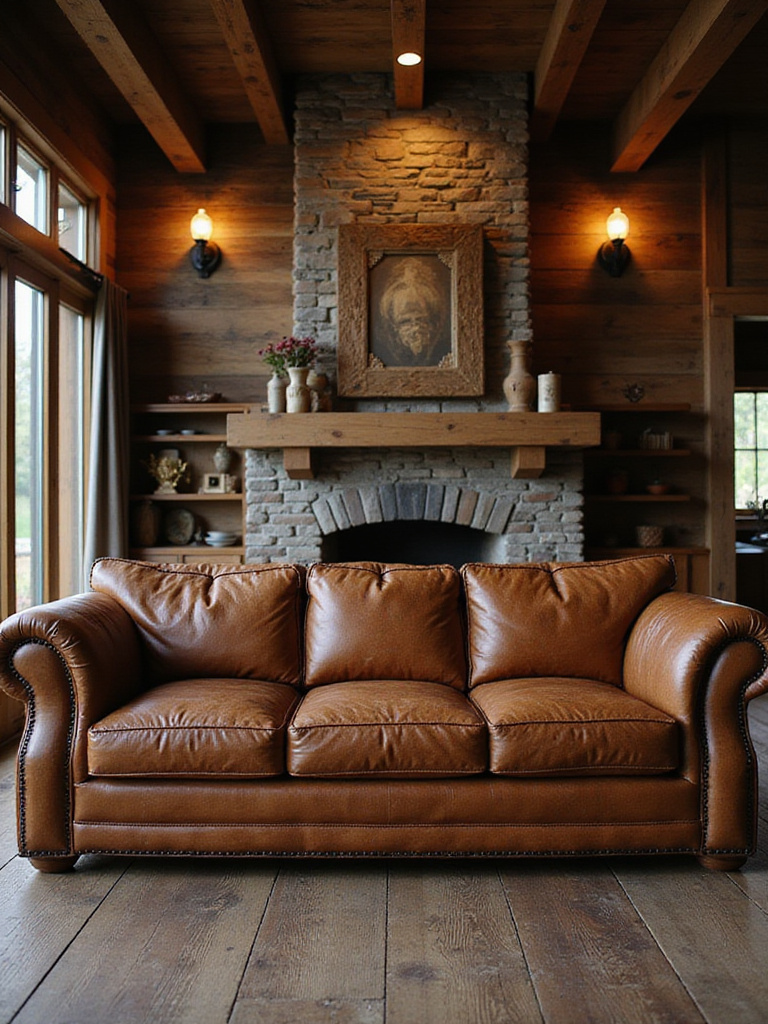
The result is upholstery that feels warm and inviting, not cold and precious. It has an almost paradoxical quality: it looks aged but feels incredibly soft and luxurious. It’s the sartorial equivalent of a beautifully broken-in pair of tweed trousers or leather brogues. This inherent character is also remarkably forgiving—new scratches or marks simply join the party, adding to the piece’s ongoing story rather than ruining it.
And this soft, aged material is the perfect foil for something harder.
13. The Industrial Touch of Wrought Iron
Wrought iron is the perfect punctuation mark in a rustic room. It adds a welcome touch of rigour and a pleasing structural honesty. Its dark, muscular presence provides a wonderful counterpoint to the warm, organic textures of wood and leather, preventing the overall scheme from becoming too soft or twee. Think of it as adding a dash of industrial heritage into the mix.
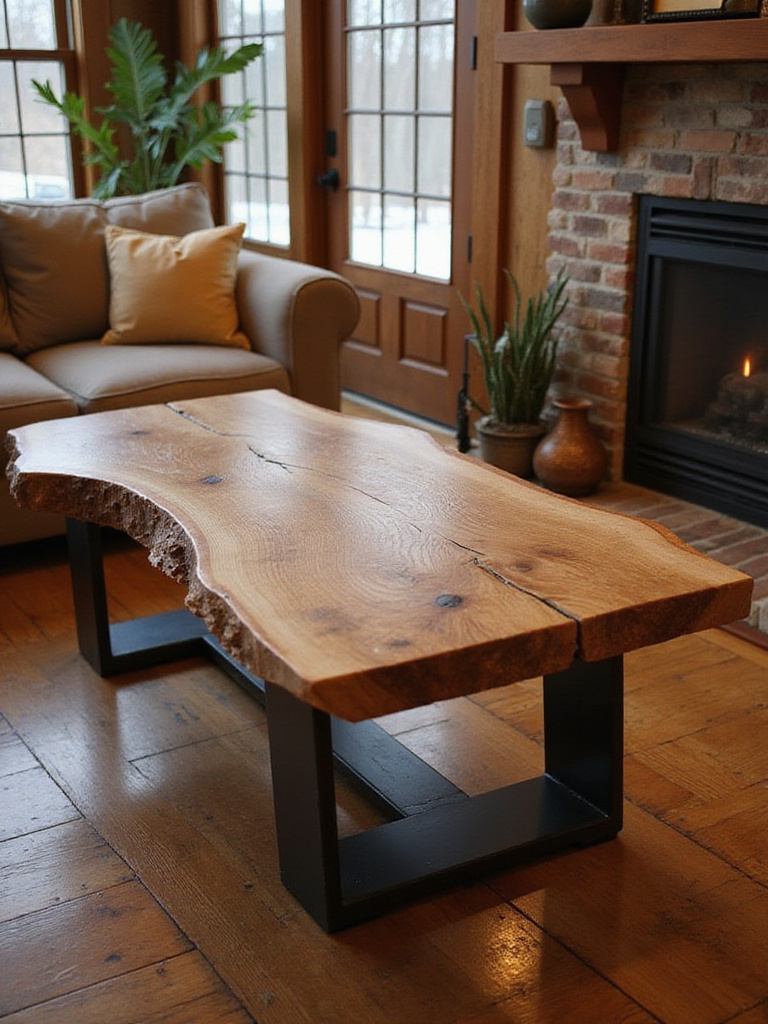
Look for it in the base of a coffee table, the brackets of a shelf, a set of fireplace tools, or a simple, sculptural floor lamp. You’re looking for signs of hand-craftsmanship—the subtle hammer marks and slight irregularities that distinguish it from mass-produced metalwork. This isn’t about creating a full-blown factory aesthetic, but about layering in an element that feels solid, purposeful, and enduring.
14. Layering Natural Fibres for a Tactile Welcome
A room can be filled with the most beautiful furniture, but without texture, it will always feel cold and flat. Layering natural fibres is what breathes life and warmth into a space. It’s about creating a rich, tactile experience that goes beyond the purely visual.
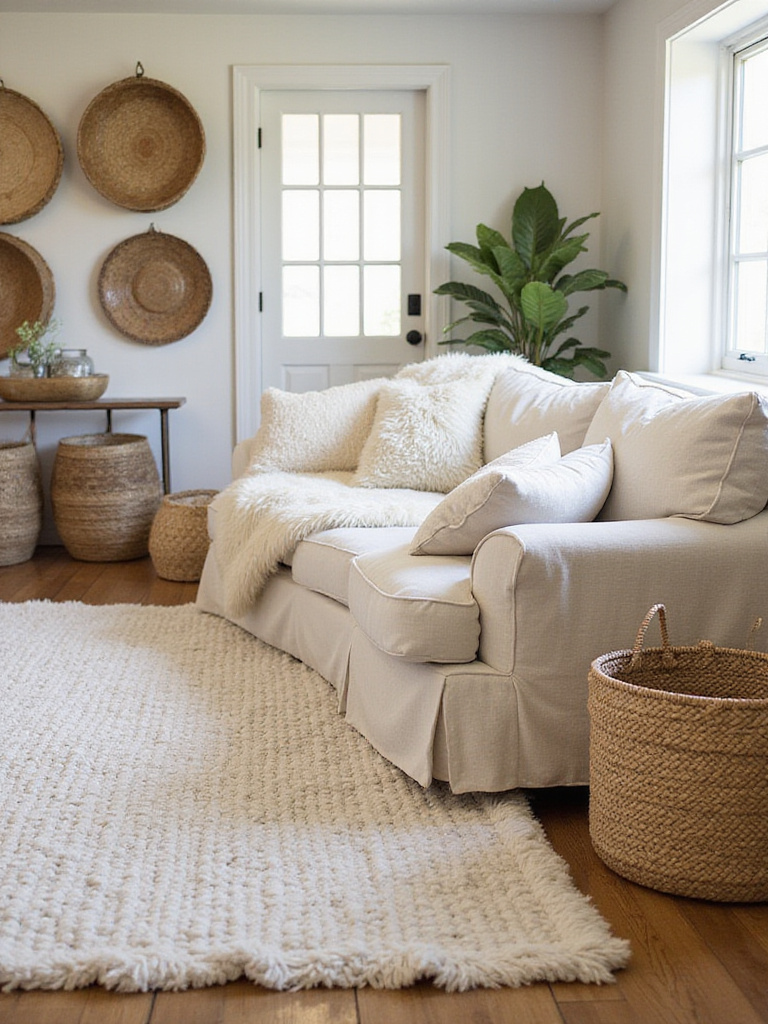
Think of it as composing a symphony of textures. The nubby weave of a wool rug underfoot, the crisp coolness of linen cushions, the soft weight of a cashmere throw draped over an armchair, and the rugged weave of a jute basket by the hearth. Each material brings its own distinct character. I advise my clients to stick to a relatively calm, neutral palette—shades of stone, oatmeal, and grey—and let the textures do the talking. The result is a room that feels complex, inviting, and deeply comforting.
15. The Art of a Farmhouse-Style Layout
The traditional farmhouse layout wasn’t driven by design theory; it was driven by life. It prioritises conversation, comfort, and practicality over rigid symmetry. The goal is to create a space that encourages people to gather and linger, not to stand on ceremony.
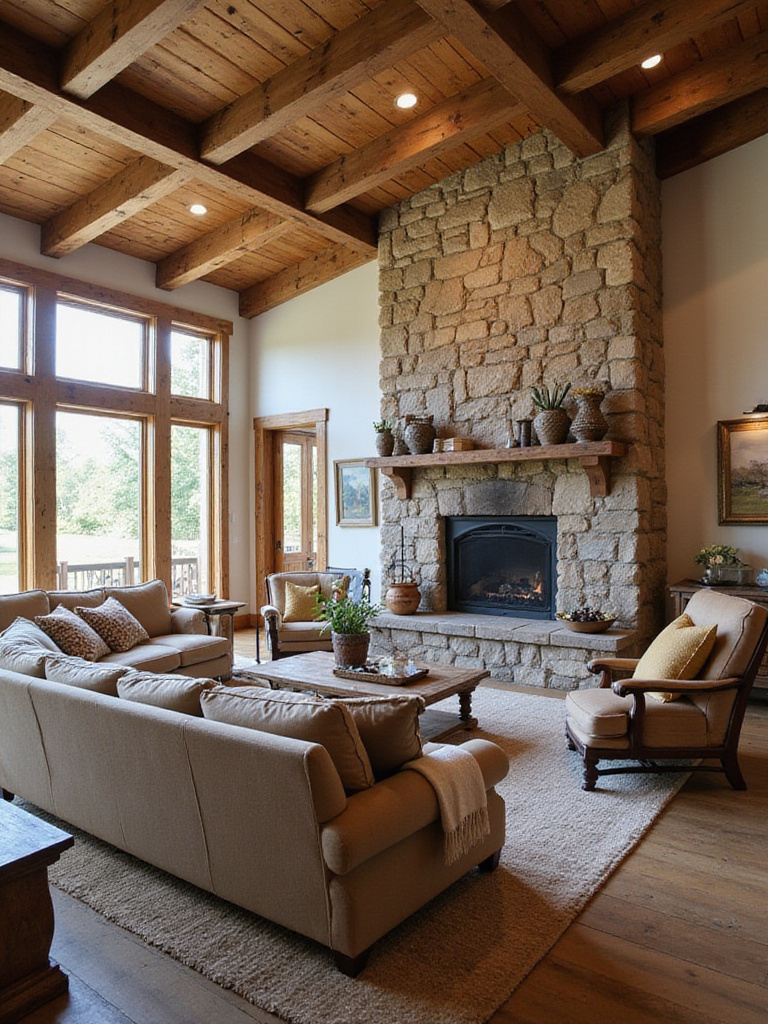
The heart of it is the conversation circle. Arrange your seating—sofas, armchairs, ottomans—so that people can speak to one another without shouting across a vast expanse. They should be close enough for intimacy but with clear pathways for moving around the room. Pull furniture away from the walls to create a more dynamic and engaging space. The best farmhouse-inspired layouts feel effortless, as though the furniture simply found its most logical and comfortable resting place over years of use.
16. The Rugged Charm of Lodge-Inspired Pieces
For a bolder, more dramatic take on rustic, one can look to the great hunting lodges of Scotland or the mountain retreats of North America. This style is all about substantial, almost monumental, pieces of furniture that exude an air of rugged permanence.
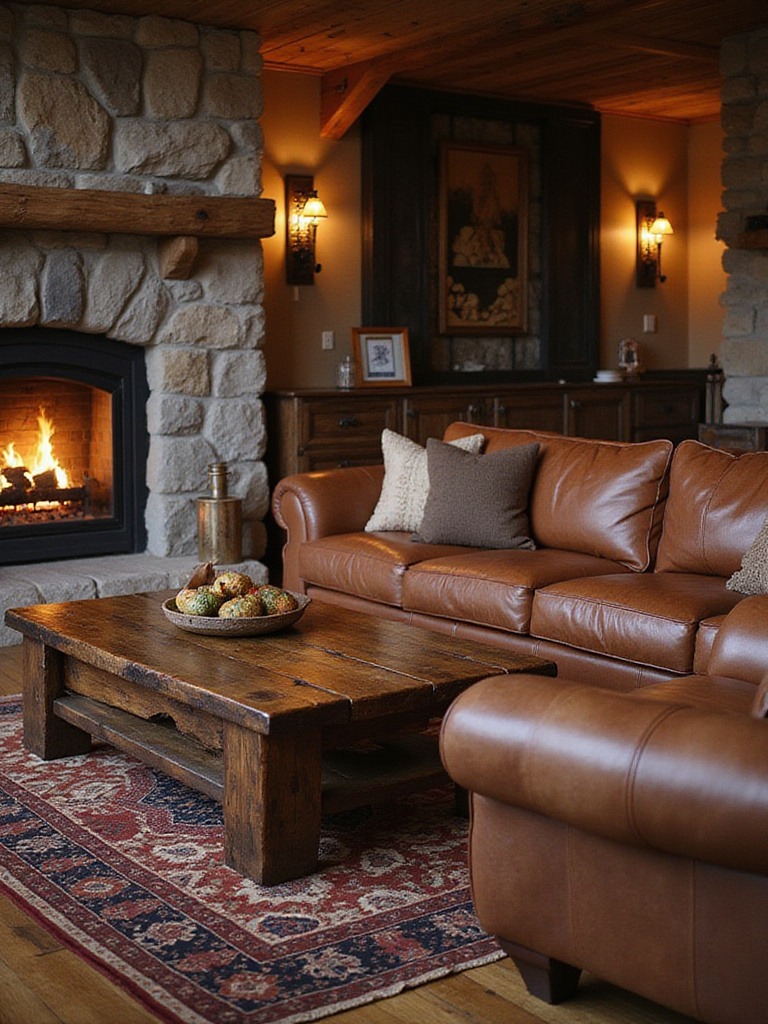
Think of a gigantic sofa you could get properly lost in, a coffee table hewn from a massive timber beam, or an armchair with the heft and presence of a throne. The scale is unapologetically grand, but the feeling is one of supreme comfort. The materials are key: thick, full-grain leathers, solid, heavy woods, and robust fabrics like tartan or herringbone tweed. This isn’t a look for the faint of heart or for a small London mews house, but in the right setting, it has a wonderfully cocooning and theatrical appeal.
17. The Chic Combination of Metal and Wood
Marrying the warmth of wood with the cool precision of metal is a hallmark of the more contemporary rustic look. It’s a chic, sophisticated dialogue between the natural and the man-made. This is where you can take a classic rustic element, like a thick plank of oak, and give it a thoroughly modern edge.
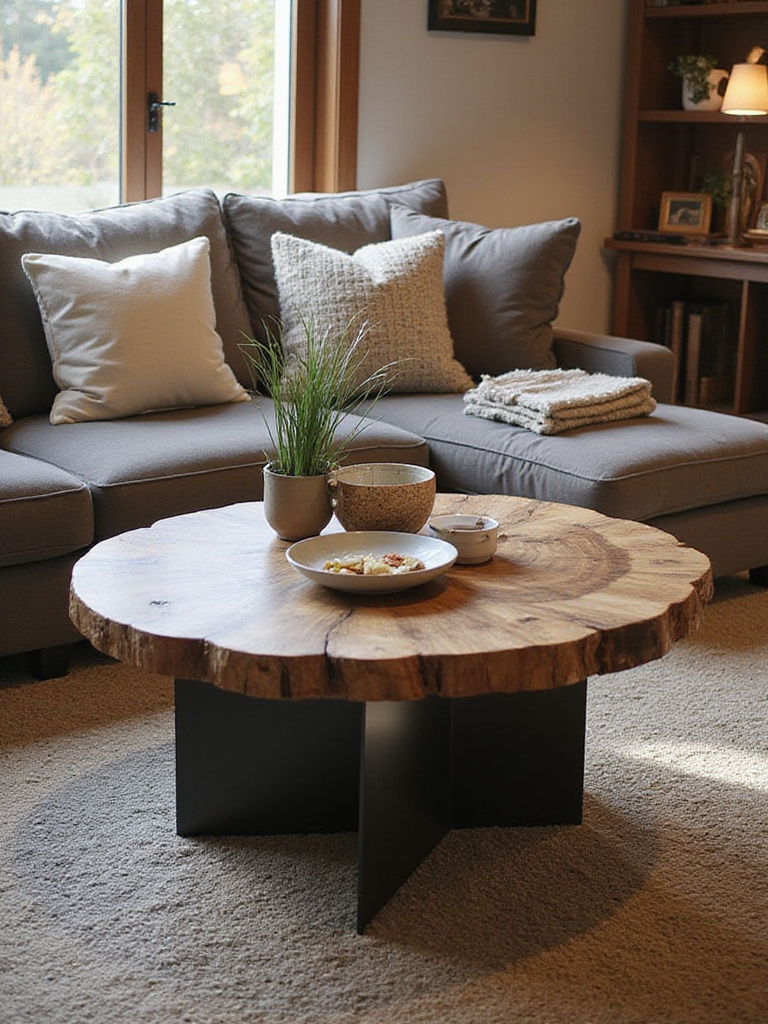
I’m particularly fond of dining tables or consoles that pair a raw, organic wooden top with a clean, minimalist metal base—perhaps in blackened or raw steel. The visual tension is immediate and compelling. It keeps the aesthetic from becoming too sentimental or “country cottage.” It’s a confident look that feels both grounded in tradition and entirely of the moment.
18. Modern Rustic: A Refined and Earthy Approach
The most current interpretation of this style—what many of my London clients are asking for—is what I call “Modern Rustic.” It’s a pared-back, more refined aesthetic. It’s less about accumulation and more about curation. The spirit is rustic, but the execution is clean.
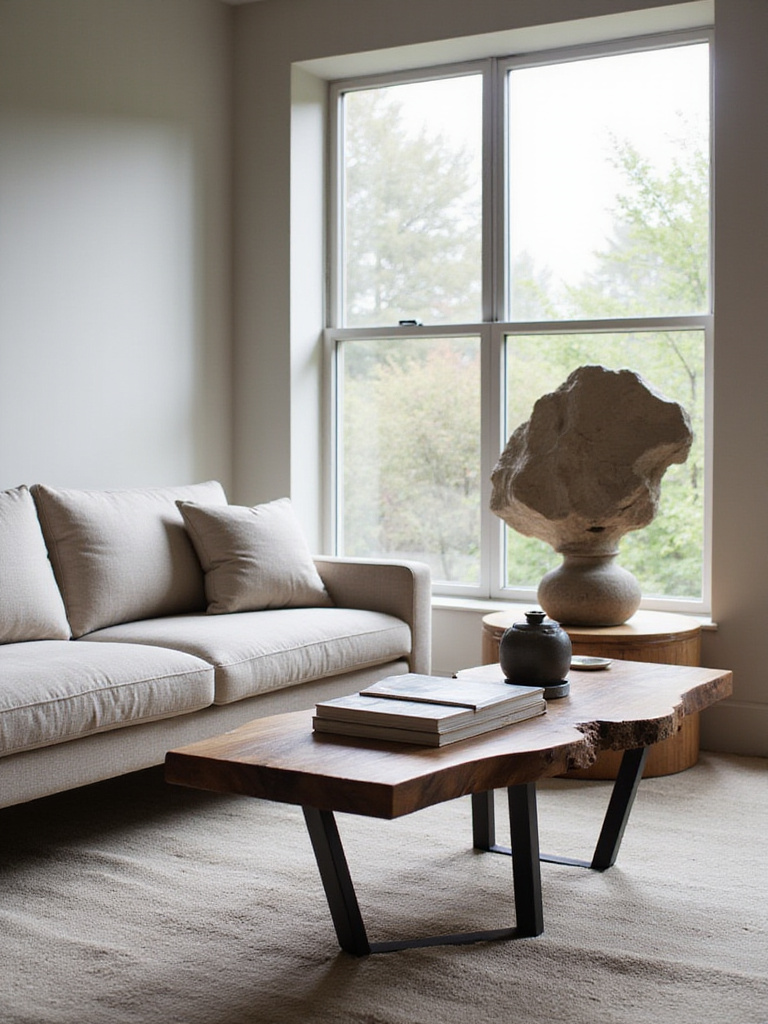
This means focusing on fewer, better pieces. Instead of a room full of charming clutter, you might have one stunning live-edge table, a beautifully proportioned sofa in a natural linen, and a single, dramatic piece of art. The colour palette is often muted and sophisticated—think warm whites, complex greys, and earthy tones that allow the materials themselves to shine. It’s about finding the beauty in simplicity and restraint, celebrating the quality of the materials over ornamentation.
19. Investing in Solid Wood: A Choice for Life
In an age of disposability, choosing solid wood furniture feels like a quiet act of rebellion. It’s an investment, to be sure, but it’s one that pays dividends for decades. Unlike its veneered or MDF cousins, solid timber ages with grace. It can be sanded down, refinished, and repaired, giving it a lifespan that can stretch across generations.
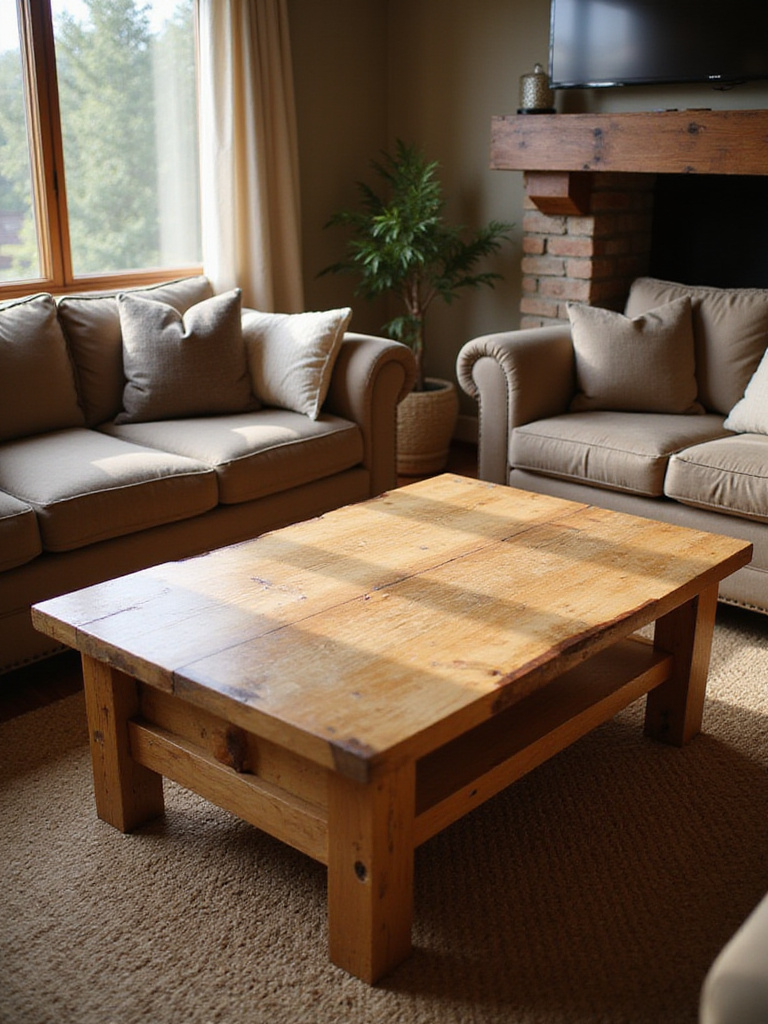
A solid oak dining table you buy today could be the very same table your grandchildren gather around. Over the years, it will acquire the marks and memories of a family’s life, deepening its character and its value. When you consider its longevity, the initial cost becomes remarkably reasonable. Whether it’s sturdy oak, rich walnut, or characterful pine, the authenticity of solid wood is something you can feel. It is the very soul of rustic design.
20. The Unapologetic Luxury of Deep, Plush Seating
Rustic design should never, ever mean sacrificing comfort. In fact, it should be the opposite. It’s about creating a haven, a place for genuine relaxation. The key to this is deep, plush, wonderfully indulgent seating.
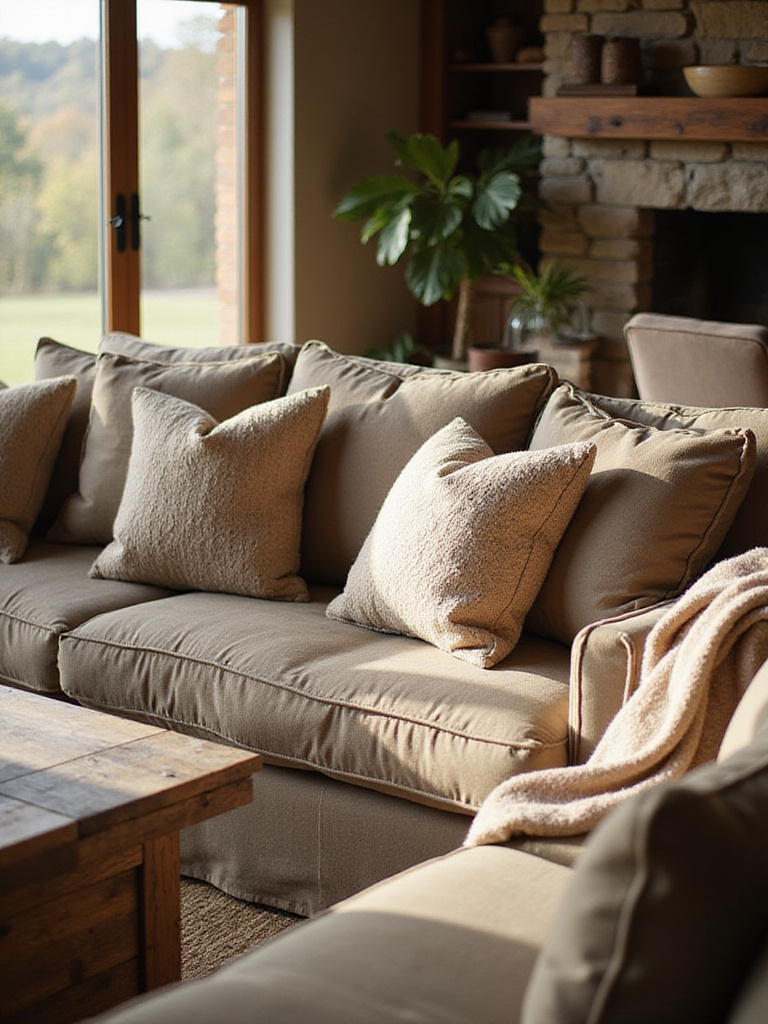
Look for sofas and armchairs with generous seat depths—at least 24 inches—that allow you to really curl up, rather than just perch. High-quality cushions are non-negotiable. I always recommend a foam core wrapped in a thick layer of feather and down. It gives you the support of foam but the delicious, sink-in softness of down. It’s this commitment to unapologetic comfort that transforms a room from a showroom into a sanctuary.
21. Getting the Scale Absolutely Right
This may be the single most important—and most frequently bungled—aspect of furnishing a room. You can have the most beautiful furniture in the world, but if it’s the wrong scale for your space, the entire scheme will collapse. A colossal sectional that was perfect in the showroom can utterly suffocate a polite Victorian drawing-room. Conversely, delicate, spindly pieces can look lost and pathetic in a grand, open-plan space.
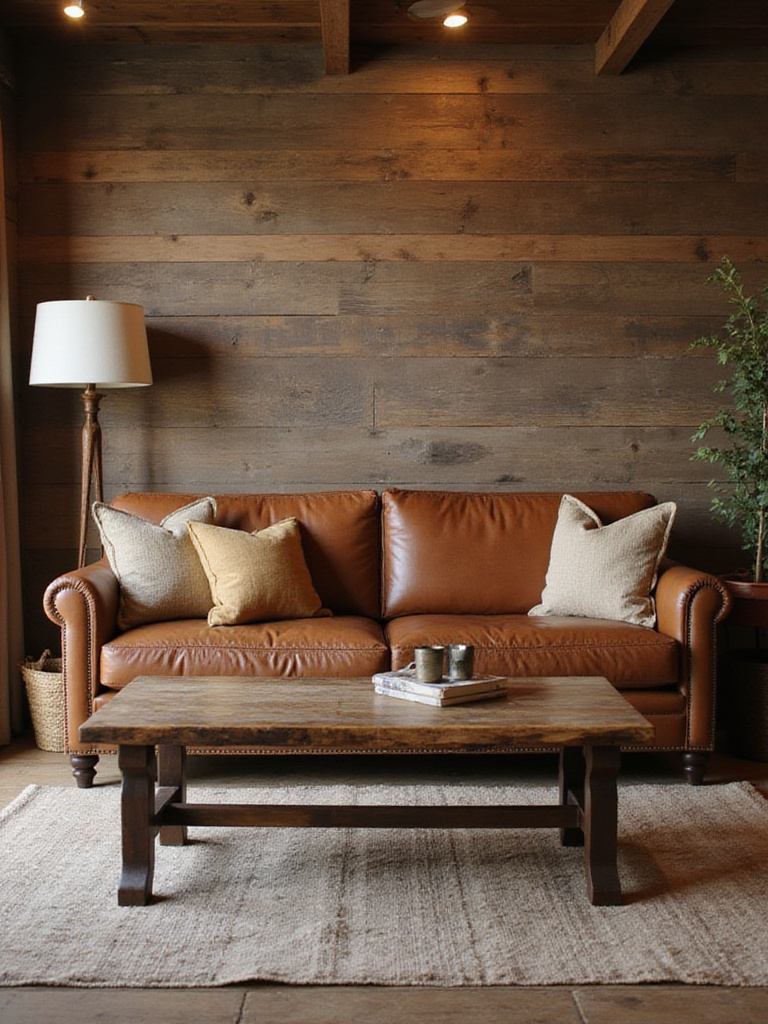
Before you buy a single thing, measure your room. Then measure it again. Make a to-scale floor plan, or map out furniture sizes on the floor with masking tape. Consider not just the footprint, but the visual weight. Ceiling height plays a huge role. Most importantly, ensure you leave ample room for traffic flow. It’s a balance—you want pieces that feel generous and comfortable, but they must respect the architectural proportions of the space they inhabit.
22. The Thrill of the Hunt in Antique Shops
For pieces with genuine, unfeignable history, there is no substitute for the antique shop, the flea market, or the salvage yard. This is where you find the one-of-a-kind treasures that give a room its soul. The thrill is in the hunt, in discovering a dusty, overlooked piece and seeing its potential.
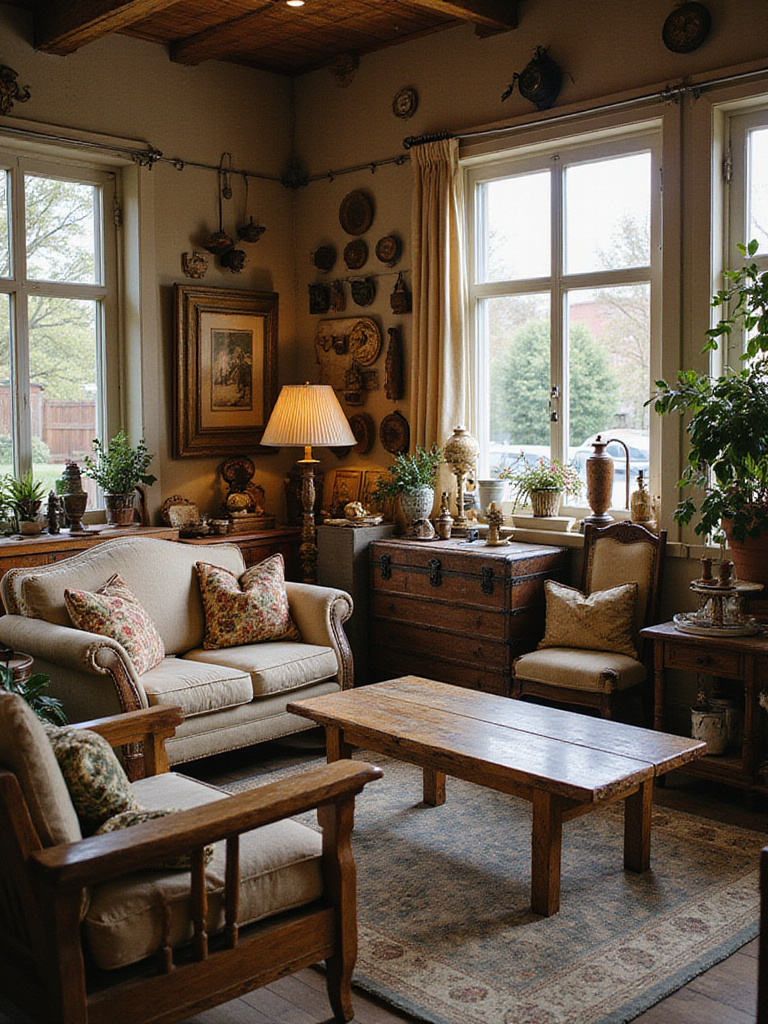
You must learn to look past the grime. That dark, dingy chest of drawers might be solid mahogany under a century of wax. That slightly wobbly farmhouse table might just need a bit of attention from a good joiner to be ready for another hundred years of service. It’s about spotting good “bones”—solid construction, quality materials, and pleasing proportions. These found objects, layered in with your newer pieces, create a home that feels collected and authentic.
23. A DIY Upgrade: Adding Your Own Chapter
Sometimes the most satisfying piece is one you’ve had a hand in yourself. Transforming an existing, perhaps unloved, piece of furniture with a bit of DIY is a wonderfully rewarding way to get a custom rustic look without the bespoke price tag. It’s also deeply sustainable.
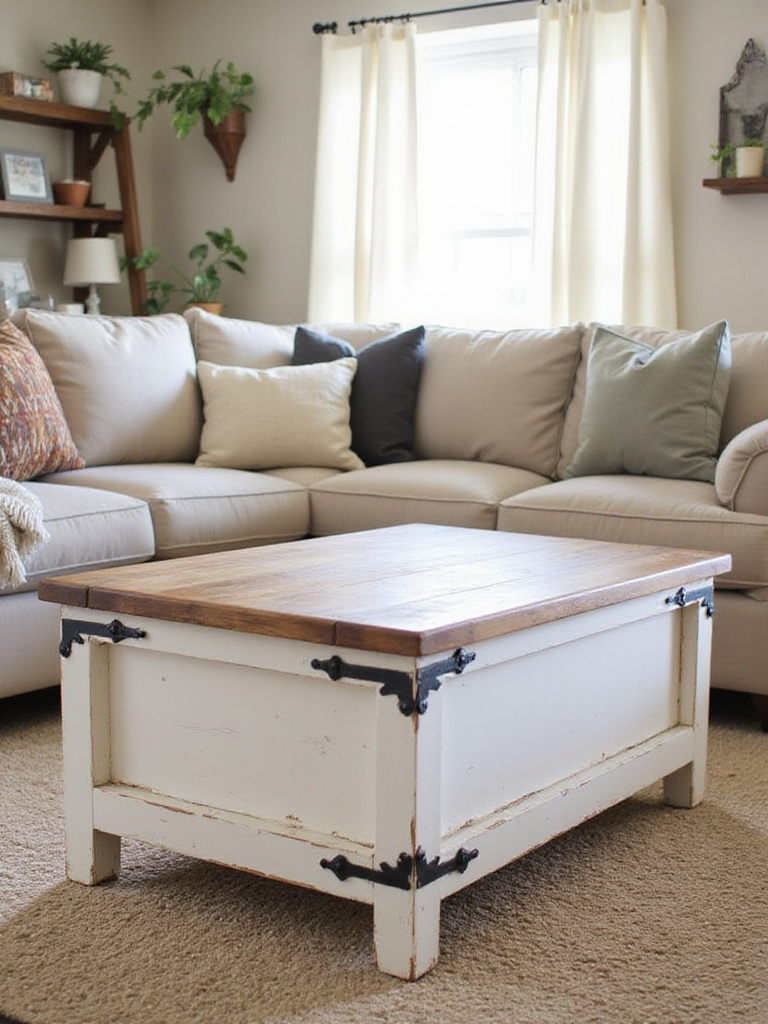
A bland pine bookcase can be given extraordinary character with a bit of dark wax and some new ironmongery. A tired old side table can be stripped back to its natural wood or given a chalky, distressed paint finish. The key is to start with a piece that is structurally sound. You’re giving it an aesthetic facelift, not performing open-heart surgery. A simple change of hardware or a new finish can be utterly transformative and allows you to add your own layer to the piece’s story.
24. A Word on Caring for Your Wood Furniture
Finally, once you’ve assembled your collection of beautiful rustic furniture, you must be its custodian. Proper care is what ensures your investment will mature beautifully. Wood is a living, breathing material, and it responds to its environment.
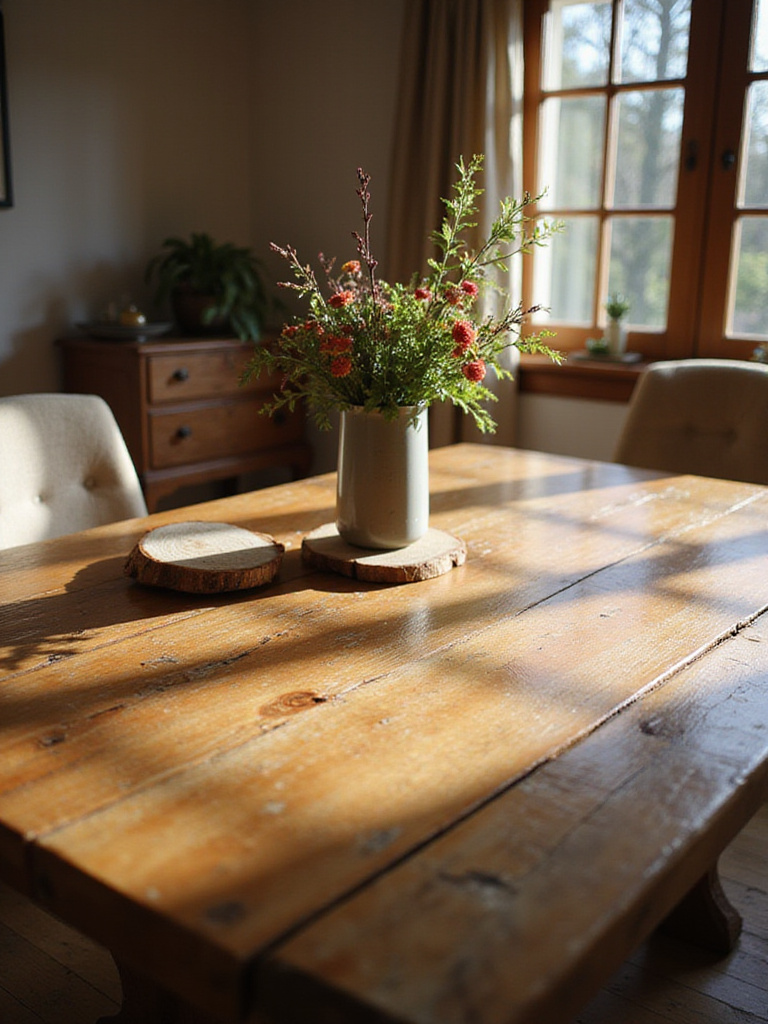
The most important thing is to avoid extremes of temperature and humidity, which can cause wood to warp or crack. Keep solid wood pieces out of direct, prolonged sunlight, which can fade the finish. Dust regularly with a soft, dry cloth. And depending on the finish—whether it’s oil, wax, or lacquer—learn the proper way to clean and feed it. A little bit of care goes a long way, allowing the wood to develop that deep, lustrous patina that is the true hallmark of a cherished heirloom.
Conclusion
In the end, creating a living room with this enduring, rustic character is less about following a set of rules and more about following your instincts. It’s about choosing pieces that speak to you, that feel good to the touch, and that promise to be faithful companions for years to come. It’s about building a room, layer by layer, that tells your story. And that, I think, is the very essence of a well-loved home.
